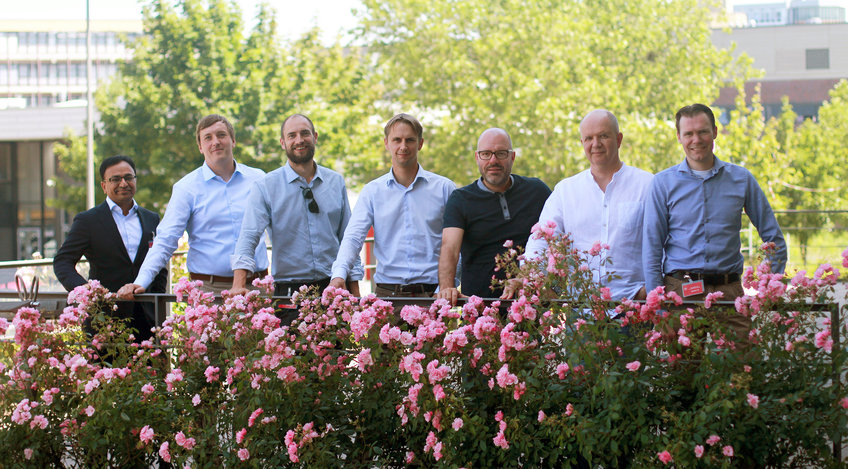
Eurostars-funding for methodological innovation in cryo electron microscopy
As a partner in a research consortium, the group of Prof. Dr. Stefan Raunser, director at the Max Planck Institute (MPI) of Molecular Physiology in Dortmund, receives considerable BMBF funding. Together with the group of Srinivas Vanapalli from the University of Twente, the Dutch companies Delmic, Demcon kryoz and CryoVac from Troisdorf, the Dortmund scientists want to develop innovative methods and improved workflows for the investigation of biomedical specimens using cryo-electron tomography. The project is funded with 2 million euros by Eurostars, a joint funding programme of the European Research Initiative EUREKA and the European Commission.
Proteins regulate all important biological processes, they are responsible for the functioning of our metabolism and for our perception of the environment. The protein haemoglobin for example carries oxygen in the blood. Muscles consist of the proteins myosin and actin. Even the smallest change in the composition of these proteins can disturb their cellular function by changing their interactions or stopping them from being in the right place at the right time - often with serious disease related consequences.
Cryo-electron microscopy (Cryo-EM), awarded the Nobel Prize in 2017, makes it possible to unveil the three-dimensional structure of proteins in almost atomic resolution and thus to investigate disease-relevant structural changes. The MPI in Dortmund is one of the leading research institutions in this field. However, the Cryo-EM field seeks to use the great potential of cryo-EM also for the investigation of large biological preparations like whole cells and tissue samples. The challenge is to visualize proteins in their functional natural environment.
One possibility is offered by a variant of the method: In cryo-electron tomography, cells or tissues are frozen at high speed. As a result, the water contained in the cells solidifies into a vitreous state which prevents the formation of ice crystals that would destroy the cell structures. The frozen preparations are then transferred to the EM, where they are examined at approx. -190°C. This workflow has to be performed as contamination-free as possible and without interrupting the cold chain. Similar to computer tomography in medical diagnostics, two-dimensional images of the sample are taken by tilting it relative to the electron beam. The series of images is than converted into a three-dimensional image.
However, due to the elaborate preparation and processing of the samples the method is associated with such a high technical effort that it is only accessible for a few laboratories in the world. The consortium, which has many years of experience in the fields of cryogenic technologies and vacuum systems, intends to use the funds to simplify the complex work processes involved in cryo tomography and thereby also to enable the examination of thicker samples like tissue sections. This includes the development of improved methods for the contamination-free transfer of samples into the microscope and the archiving of frozen specimens. With the introduction of the new workflow CETFlow (Cryogenic Electron Tomography WorkFlow), cryo-electron tomography is to be made accessible to a larger group of users, so that the technology can also be applied for specific medical questions.
Information about the partners
Delmic
Project leader of the consortium is Delmic, a medium-sized Dutch company with excellent experience in the field of correlative light and electron microscopy.
Demcon kryoz
Demcon kryoz is a Dutch company and belongs to teh Demcon group with more than 600 employees. Demcon kryoz develops innovative cooling technologies and solutions for various applications, including medical, aerospace and research applications. The expertise lies in the development of cryogenic platforms.
CryoVac
CryoVAC low temperature technologies inc. is a medium-sized company from Troisdorf and has a long tradition in the production of cryogenic and vacuum systems.
Laboratory of Prof. Dr. Srinivas Vanapalli Lab, University of Twente
The group of Srinivas Vanapalli at the University of Twente investigates new cooling systems.
Information about Eurostars
With Eurostars the Federal Ministry of Education and Research (BMBF) is supporting innovative product development in European cooperation projects.
Eurostars is a joint funding programme of EUREKA and the European Commission, which will be continued under the name Eurostars 2 under the horizon 2020. The aim of Eurostars is to motivate small and medium-sized enterprises (SMEs) more strongly for European cooperation in research and development projects. Eurostars works according to the same principle as the EUREKA initiative: Eurostars projects are open to technology and serve civil purposes. They aim to develop an innovative product, process or service. According to the so-called "bottom-up principle", the project contents can be freely determined by the participating partners.